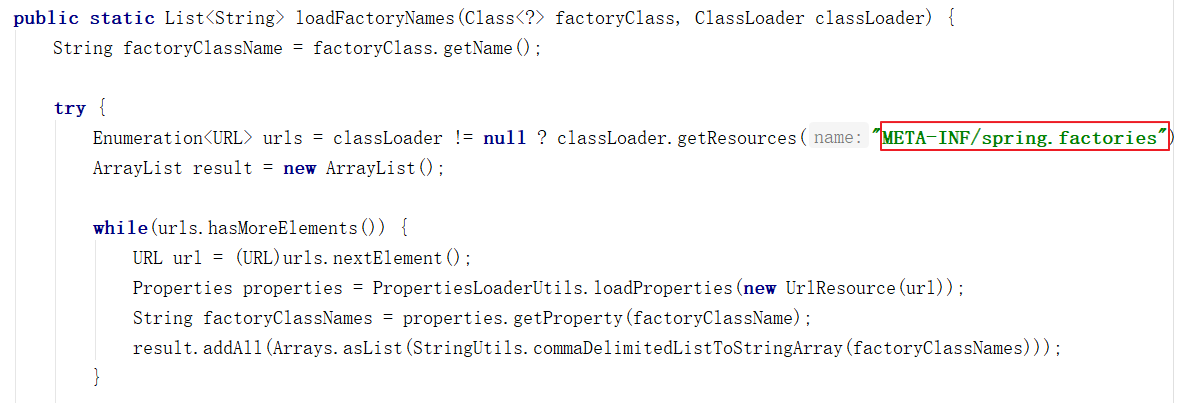Spring Boot中如何自定义starter?
Spring Boot starter
我们知道Spring Boot大大简化了项目初始搭建以及开发过程,而这些都是通过Spring Boot提供的starter来完成的。品达通用权限系统就是基于Spring Boot进行开发,而且一些基础模块其本质就是starter,所以我们需要对Spring Boot的starter有一个全面深入的了解,这是我们开发品达通用权限系统的必备知识。
1 starter介绍
spring boot 在配置上相比spring要简单许多, 其核心在于spring-boot-starter, 在使用spring boot来搭建一个项目时, 只需要引入官方提供的starter, 就可以直接使用, 免去了各种配置。starter简单来讲就是引入了一些相关依赖和一些初始化的配置。
Spring官方提供了很多starter,第三方也可以定义starter。为了加以区分,starter从名称上进行了如下规范:
[ ] Spring官方提供的starter名称为:spring-boot-starter-xxx
例如Spring官方提供的spring-boot-starter-web
[ ] 第三方提供的starter名称为:xxx-spring-boot-starter
例如由mybatis提供的mybatis-spring-boot-starter
2 starter原理
Spring Boot之所以能够帮我们简化项目的搭建和开发过程,主要是基于它提供的起步依赖和自动配置。
2.1 起步依赖
起步依赖,其实就是将具备某种功能的坐标打包到一起,可以简化依赖导入的过程。例如,我们导入spring-boot-starter-web这个starter,则和web开发相关的jar包都一起导入到项目中了。如下图所示:

2.2 自动配置
自动配置,就是无须手动配置xml,自动配置并管理bean,可以简化开发过程。那么Spring Boot是如何完成自动配置的呢?
自动配置涉及到如下几个关键步骤:
- 基于Java代码的Bean配置
- 自动配置条件依赖
- Bean参数获取
- Bean的发现
- Bean的加载
我们可以通过一个实际的例子mybatis-spring-boot-starter来说明自动配置的实现过程。
2.2.1 基于Java代码的Bean配置
当我们在项目中导入了mybatis-spring-boot-starter这个jar后,可以看到它包括了很多相关的jar包,如下图:

其中在mybatis-spring-boot-autoconfigure这个jar包中有如下一个MybatisAutoConfiguration自动配置类:

打开这个类,截取的关键代码如下:


@Configuration和@Bean这两个注解一起使用就可以创建一个基于java代码的配置类,可以用来替代传统的xml配置文件。
@Configuration 注解的类可以看作是能生产让Spring IoC容器管理的Bean实例的工厂。
@Bean 注解的方法返回的对象可以被注册到spring容器中。
所以上面的MybatisAutoConfiguration这个类,自动帮我们生成了SqlSessionFactory和SqlSessionTemplate这些Mybatis的重要实例并交给spring容器管理,从而完成bean的自动注册。
2.2.2 自动配置条件依赖
从MybatisAutoConfiguration这个类中使用的注解可以看出,要完成自动配置是有依赖条件的。

所以要完成Mybatis的自动配置,需要在类路径中存在SqlSessionFactory.class、SqlSessionFactoryBean.class这两个类,同时需要存在DataSource这个bean且这个bean完成自动注册。
这些注解是spring boot特有的,常见的条件依赖注解有:
| 注解 | 功能说明 |
|---|---|
| @ConditionalOnBean | 仅在当前上下文中存在某个bean时,才会实例化这个Bean |
| @ConditionalOnClass | 某个class位于类路径上,才会实例化这个Bean |
| @ConditionalOnExpression | 当表达式为true的时候,才会实例化这个Bean |
| @ConditionalOnMissingBean | 仅在当前上下文中不存在某个bean时,才会实例化这个Bean |
| @ConditionalOnMissingClass | 某个class在类路径上不存在的时候,才会实例化这个Bean |
| @ConditionalOnNotWebApplication | 不是web应用时才会实例化这个Bean |
| @AutoConfigureAfter | 在某个bean完成自动配置后实例化这个bean |
| @AutoConfigureBefore | 在某个bean完成自动配置前实例化这个bean |
2.2.3 Bean参数获取
要完成mybatis的自动配置,需要我们在配置文件中提供数据源相关的配置参数,例如数据库驱动、连接url、数据库用户名、密码等。那么spring boot是如何读取yml或者properites配置文件的的属性来创建数据源对象的?
在我们导入mybatis-spring-boot-starter这个jar包后会传递过来一个spring-boot-autoconfigure包,在这个包中有一个自动配置类DataSourceAutoConfiguration,如下所示:
!
我们可以看到这个类上加入了EnableConfigurationProperties这个注解,继续跟踪源码到DataSourceProperties这个类,如下:

可以看到这个类上加入了ConfigurationProperties注解,这个注解的作用就是把yml或者properties配置文件中的配置参数信息封装到ConfigurationProperties注解标注的bean(即DataSourceProperties)的相应属性上。
@EnableConfigurationProperties注解的作用是使@ConfigurationProperties注解生效。
2.2.4 Bean的发现
spring boot默认扫描启动类所在的包下的主类与子类的所有组件,但并没有包括依赖包中的类,那么依赖包中的bean是如何被发现和加载的?
我们需要从Spring Boot项目的启动类开始跟踪,在启动类上我们一般会加入SpringBootApplication注解,此注解的源码如下:

重点介绍如下三个注解:
SpringBootConfiguration:作用就相当于Configuration注解,被注解的类将成为一个bean配置类
ComponentScan:作用就是自动扫描并加载符合条件的组件,最终将这些bean加载到spring容器中
EnableAutoConfiguration :这个注解很重要,借助@Import的支持,收集和注册依赖包中相关的bean定义
继续跟踪EnableAutoConfiguration注解源码:

@EnableAutoConfiguration注解引入了@Import这个注解。
Import:导入需要自动配置的组件,此处为EnableAutoConfigurationImportSelector这个类
EnableAutoConfigurationImportSelector类源码如下:

EnableAutoConfigurationImportSelector继承了AutoConfigurationImportSelector类,继续跟踪AutoConfigurationImportSelector类源码:

AutoConfigurationImportSelector类的getCandidateConfigurations方法中的调用了SpringFactoriesLoader类的loadFactoryNames方法,继续跟踪源码:

SpringFactoriesLoader的loadFactoryNames静态方法可以从所有的jar包中读取META-INF/spring.factories文件,而自动配置的类就在这个文件中进行配置:

spring.factories文件内容如下:
这样Spring Boot就可以加载到MybatisAutoConfiguration这个配置类了。
2.2.5 Bean的加载
在Spring Boot应用中要让一个普通类交给Spring容器管理,通常有以下方法:
1、使用 @Configuration与@Bean 注解
2、使用@Controller @Service @Repository @Component 注解标注该类并且启用@ComponentScan自动扫描
3、使用@Import 方法
其中Spring Boot实现自动配置使用的是@Import注解这种方式,AutoConfigurationImportSelector类的selectImports方法返回一组从META-INF/spring.factories文件中读取的bean的全类名,这样Spring Boot就可以加载到这些Bean并完成实例的创建工作。
2.3 自动配置总结
我们可以将自动配置的关键几步以及相应的注解总结如下:
1、@Configuration与@Bean:基于Java代码的bean配置
2、@Conditional:设置自动配置条件依赖
3、@EnableConfigurationProperties与@ConfigurationProperties:读取配置文件转换为bean
4、@EnableAutoConfiguration与@Import:实现bean发现与加载
3 自定义starter
本小节我们通过自定义两个starter来加强starter的理解和应用。
3.1 案例一
3.1.1 开发starter
第一步:创建starter工程hello-spring-boot-starter并配置pom.xml文件
<?xml version="1.0" encoding="UTF-8"?>
<project xmlns="http://maven.apache.org/POM/4.0.0"
xmlns:xsi="http://www.w3.org/2001/XMLSchema-instance"
xsi:schemaLocation="http://maven.apache.org/POM/4.0.0
http://maven.apache.org/xsd/maven-4.0.0.xsd">
<modelVersion>4.0.0</modelVersion>
<parent>
<groupId>org.springframework.boot</groupId>
<artifactId>spring-boot-starter-parent</artifactId>
<version>2.2.2.RELEASE</version>
<relativePath/>
</parent>
<groupId>cn.pf</groupId>
<artifactId>hello-spring-boot-starter</artifactId>
<version>1.0-SNAPSHOT</version>
<dependencies>
<dependency>
<groupId>org.springframework.boot</groupId>
<artifactId>spring-boot-starter</artifactId>
</dependency>
<dependency>
<groupId>org.springframework.boot</groupId>
<artifactId>spring-boot-autoconfigure</artifactId>
</dependency>
</dependencies>
</project>
第二步:创建配置属性类HelloProperties
package cn.pf.config;
import org.springframework.boot.context.properties.ConfigurationProperties;
/*
*读取配置文件转换为bean
* */
@ConfigurationProperties(prefix = "hello")
public class HelloProperties {
private String name;
private String address;
public String getName() {
return name;
}
public void setName(String name) {
this.name = name;
}
public String getAddress() {
return address;
}
public void setAddress(String address) {
this.address = address;
}
@Override
public String toString() {
return "HelloProperties{" +
"name='" + name + '\'' +
", address='" + address + '\'' +
'}';
}
}
第三步:创建服务类HelloService
package cn.pf.service;
public class HelloService {
private String name;
private String address;
public HelloService(String name, String address) {
this.name = name;
this.address = address;
}
public String sayHello(){
return "你好!我的名字叫 " + name + ",我来自 " + address;
}
}
第四步:创建自动配置类HelloServiceAutoConfiguration
package cn.pf.config;
import cn.pf.service.HelloService;
import org.springframework.boot.autoconfigure.condition.ConditionalOnMissingBean;
import org.springframework.boot.context.properties.EnableConfigurationProperties;
import org.springframework.context.annotation.Bean;
import org.springframework.context.annotation.Configuration;
/*
* 配置类,基于Java代码的bean配置
* */
@Configuration
@EnableConfigurationProperties(HelloProperties.class)
public class HelloServiceAutoConfiguration {
private HelloProperties helloProperties;
//通过构造方法注入配置属性对象HelloProperties
public HelloServiceAutoConfiguration(HelloProperties helloProperties) {
this.helloProperties = helloProperties;
}
//实例化HelloService并载入Spring IoC容器
@Bean
@ConditionalOnMissingBean
public HelloService helloService(){
return new HelloService(helloProperties.getName(),helloProperties.getAddress());
}
}
第五步:在resources目录下创建META-INF/spring.factories
org.springframework.boot.autoconfigure.EnableAutoConfiguration=\
cn.pf.config.HelloServiceAutoConfiguration
至此starter已经开发完成了,可以将当前starter安装到本地maven仓库供其他应用来使用。
3.1.2 使用starter
第一步:创建maven工程myapp并配置pom.xml文件
<?xml version="1.0" encoding="UTF-8"?>
<project xmlns="http://maven.apache.org/POM/4.0.0"
xmlns:xsi="http://www.w3.org/2001/XMLSchema-instance"
xsi:schemaLocation="http://maven.apache.org/POM/4.0.0 http://maven.apache.org/xsd/maven-4.0.0.xsd">
<modelVersion>4.0.0</modelVersion>
<parent>
<groupId>org.springframework.boot</groupId>
<artifactId>spring-boot-starter-parent</artifactId>
<version>2.2.2.RELEASE</version>
<relativePath/>
</parent>
<groupId>cn.pf</groupId>
<artifactId>myapp</artifactId>
<version>1.0-SNAPSHOT</version>
<dependencies>
<dependency>
<groupId>org.springframework.boot</groupId>
<artifactId>spring-boot-starter-web</artifactId>
</dependency>
<!--导入自定义starter-->
<dependency>
<groupId>cn.pf</groupId>
<artifactId>hello-spring-boot-starter</artifactId>
<version>1.0-SNAPSHOT</version>
</dependency>
</dependencies>
</project>
第二步:创建application.yml文件
server:
port: 8080
hello:
name: xiaoming
address: beijing
第三步:创建HelloController
package cn.pf.controller;
import cn.pf.service.HelloService;
import org.springframework.beans.factory.annotation.Autowired;
import org.springframework.web.bind.annotation.GetMapping;
import org.springframework.web.bind.annotation.RequestMapping;
import org.springframework.web.bind.annotation.RestController;
@RestController
@RequestMapping("/hello")
public class HelloController {
//HelloService在我们自定义的starter中已经完成了自动配置,所以此处可以直接注入
@Autowired
private HelloService helloService;
@GetMapping("/say")
public String sayHello(){
return helloService.sayHello();
}
}
第四步:创建启动类HelloApplication
package cn.pf;
import org.springframework.boot.SpringApplication;
import org.springframework.boot.autoconfigure.SpringBootApplication;
@SpringBootApplication
public class HelloApplication {
public static void main(String[] args) {
SpringApplication.run(HelloApplication.class,args);
}
}
执行启动类main方法,访问地址http://localhost:8080/hello/say

3.2 案例二
在前面的案例一中我们通过定义starter,自动配置了一个HelloService实例。本案例我们需要通过自动配置来创建一个拦截器对象,通过此拦截器对象来实现记录日志功能。
我们可以在案例一的基础上继续开发案例二。
3.2.1 开发starter
第一步:在hello-spring-boot-starter的pom.xml文件中追加如下maven坐标
<dependency>
<groupId>org.springframework.boot</groupId>
<artifactId>spring-boot-starter-web</artifactId>
<optional>true</optional>
</dependency>
<dependency>
<groupId>org.springframework.boot</groupId>
<artifactId>spring-boot-configuration-processor</artifactId>
</dependency>
第二步:自定义MyLog注解
package cn.pf.log;
import java.lang.annotation.ElementType;
import java.lang.annotation.Retention;
import java.lang.annotation.RetentionPolicy;
import java.lang.annotation.Target;
@Target(ElementType.METHOD)
@Retention(RetentionPolicy.RUNTIME)
public @interface MyLog {
/**
* 方法描述
*/
String desc() default "";
}
第三步:自定义日志拦截器MyLogInterceptor
package cn.pf.log;
import org.springframework.web.method.HandlerMethod;
import org.springframework.web.servlet.ModelAndView;
import org.springframework.web.servlet.handler.HandlerInterceptorAdapter;
import javax.servlet.http.HttpServletRequest;
import javax.servlet.http.HttpServletResponse;
import java.lang.reflect.Method;
/**
* 日志拦截器
*/
public class MyLogInterceptor extends HandlerInterceptorAdapter {
private static final ThreadLocal<Long> startTimeThreadLocal = new ThreadLocal<>();
public boolean preHandle(HttpServletRequest request, HttpServletResponse response,
Object handler) throws Exception {
HandlerMethod handlerMethod = (HandlerMethod)handler;
Method method = handlerMethod.getMethod();//获得被拦截的方法对象
MyLog myLog = method.getAnnotation(MyLog.class);//获得方法上的注解
if(myLog != null){
//方法上加了MyLog注解,需要进行日志记录
long startTime = System.currentTimeMillis();
startTimeThreadLocal.set(startTime);
}
return true;
}
public void postHandle(HttpServletRequest request, HttpServletResponse response,
Object handler, ModelAndView modelAndView) throws Exception {
HandlerMethod handlerMethod = (HandlerMethod)handler;
Method method = handlerMethod.getMethod();//获得被拦截的方法对象
MyLog myLog = method.getAnnotation(MyLog.class);//获得方法上的注解
if(myLog != null){
//方法上加了MyLog注解,需要进行日志记录
long endTime = System.currentTimeMillis();
Long startTime = startTimeThreadLocal.get();
long optTime = endTime - startTime;
String requestUri = request.getRequestURI();
String methodName = method.getDeclaringClass().getName() + "." +
method.getName();
String methodDesc = myLog.desc();
System.out.println("请求uri:" + requestUri);
System.out.println("请求方法名:" + methodName);
System.out.println("方法描述:" + methodDesc);
System.out.println("方法执行时间:" + optTime + "ms");
}
}
}
第四步:创建自动配置类MyLogAutoConfiguration,用于自动配置拦截器、参数解析器等web组件
package cn.pf.config;
import cn.pf.log.MyLogInterceptor;
import org.springframework.context.annotation.Configuration;
import org.springframework.web.servlet.config.annotation.InterceptorRegistry;
import org.springframework.web.servlet.config.annotation.WebMvcConfigurer;
/**
* 配置类,用于自动配置拦截器、参数解析器等web组件
*/
@Configuration
public class MyLogAutoConfiguration implements WebMvcConfigurer{
//注册自定义日志拦截器
public void addInterceptors(InterceptorRegistry registry) {
registry.addInterceptor(new MyLogInterceptor());
}
}
第五步:在spring.factories中追加MyLogAutoConfiguration配置
org.springframework.boot.autoconfigure.EnableAutoConfiguration=\
cn.pf.config.HelloServiceAutoConfiguration,\
cn.pf.config.MyLogAutoConfiguration
注意:我们在hello-spring-boot-starter中追加了新的内容,需要重新打包安装到maven仓库。
3.2.2 使用starter
在myapp工程的Controller方法上加入@MyLog注解
package cn.pf.controller;
import cn.pf.log.MyLog;
import cn.pf.service.HelloService;
import org.springframework.beans.factory.annotation.Autowired;
import org.springframework.web.bind.annotation.GetMapping;
import org.springframework.web.bind.annotation.RequestMapping;
import org.springframework.web.bind.annotation.RestController;
@RestController
@RequestMapping("/hello")
public class HelloController {
//HelloService在我们自定义的starter中已经完成了自动配置,所以此处可以直接注入
@Autowired
private HelloService helloService;
@MyLog(desc = "sayHello方法") //日志记录注解
@GetMapping("/say")
public String sayHello(){
return helloService.sayHello();
}
}
访问地址:http://localhost:8080/hello/say
,查看控制台输出:
请求uri:/hello/say
请求方法名:cn.pf.controller.HelloController.sayHello
方法描述:sayHello方法
方法执行时间:36ms
最新文章
- jQuery 追加元素的方法如append、prepend、before,after(转)
- SQL SERVER 2008
- Confluent介绍(一)
- NSOperation创建队列
- web应用防火墙 – 安全伞18.5.1免费版本发布
- 泛型Dictionary的用法详解
- DWZ 刷新 dialog
- Javascript预解析、作用域、作用域链
- 【转】USB协议架构及驱动架构
- [虚拟化/云] kvm的架构分析
- 从并发处理谈PHP进程间通信(一)外部介质
- C#断点调试时属性get块逻辑执行多次
- input框中修改placeholder的样式
- python-时间模块,random、os、sys、shutil、json和pickle模块
- windows下安装mysql遇到的问题
- redis的一命令
- npm和yarn的使用对比
- 【转载】 A* 寻路算法 (个人认为最详细,最通俗易懂的一个版本)
- 第8章 传输层(3)_TCP协议
- SpringCloud之Ribbon